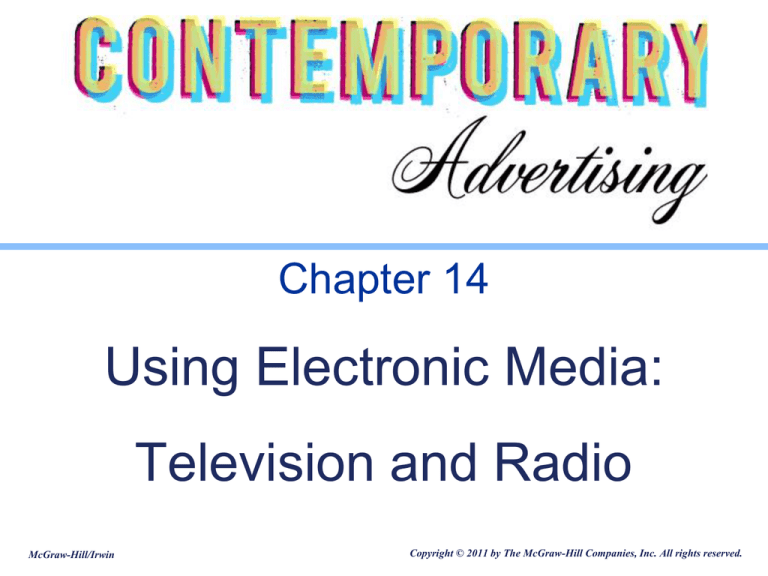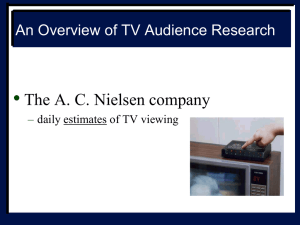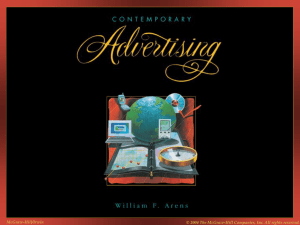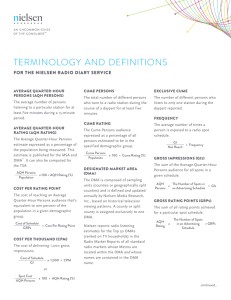
Chapter 14
Using Electronic Media:
Television and Radio
McGraw-Hill/Irwin
Copyright © 2011 by The McGraw-Hill Companies, Inc. All rights reserved.
Chapter Overview
Factors to evaluate when considering
radio & television in the creative mix
14-2
Chapter Objectives
Describe pros & cons
of broadcast TV as an
ad medium
Describe TV audience
measurement
Discuss the pros and
cons of cable TV ads
Discuss factors to
consider when buying
TV time
Explain the process of
buying cable and
broadcast TV time
Analyze pros & cons of
radio in the creative mix
Evaluate different types
of TV advertising
Discuss factors to
consider when buying
radio time
14-3
The Medium of Television
Broadcast TV
Cable TV
VHF and UHF
Premium Services
Independent Stations
Ad-Supported Networks
Network Affiliates
Superstations
14-4
TV Audience Trends
Demographics
Cable households
DVD Rental
Viewing patterns
TV viewing hours
Audience fragmentation
14-5
The Medium of Television
Pros
Cons
Mass coverage
High production cost
Relatively low cost
High airtime cost
Some selectivity
Limited selectivity
Impact
Brevity
Creativity
Clutter
Prestige
Zipping and zapping
Social dominance
14-6
Cable TV Pros and Cons
Pros
Cons
Selectivity
Limited reach
Audience demographics
Fragmentation
Low cost
Quality
Flexibility
Zipping and zapping
Testability
14-7
The Medium of Television
How adult viewers rate various media
14-8
Types of TV Advertising
Sponsorship
Participation basis
Syndication
Spot ads
Infomercials
14-9
Network & Syndication Distribution
14-10
TV Ad Spending (Billions)
Network TV dominates, but is losing ground
14-11
Types of TV Advertising
Prime time’s
most expensive
30-second
spots
http://www.fr
ankwbaker.c
om/2006_20
07_ad_rates.
htm
1612
Insert ex. 16-7, p.
517
Ad cost per 30-sec
spot
Position = 2.9”horiz.,
1.5” vertical
Size = 4.6” TALL
Resolution: 300 dpi
14-12
Most Expensive 30-Second Spots
14-13
TV Audience Measurement
Rating
Services
Defining TV
Markets
Dayparts
Audience
Measures
Nielsen &
Others
Cable Ratings
14-14
TV Audience Measurement
Rating
Services
Defining TV
Markets
Nielsen & Others
Designated
Market Areas
Dayparts
Audience
Measures
Cable Ratings
14-15
Designated Market Area
Columbus, Georgia designated market area
14-16
TV Audience Measurement
Rating
Services
Defining TV
Markets
Nielsen &
Others
Designated
Market Areas
Cable Ratings
Dayparts
Audience
Measures
Daytime 9 a.m. – 4 p.m.
Early Fringe 4 – 5:30 p.m..
Early News 5 or 5:30 – 7:30 p.m.
Access 7:30 – 8 p.m.
Prime Time 8 – 11 p.m.
Late News 11 – 11:30 p.m.
Late Fringe 11:30 – 1 a.m.
14-17
TV Audience Measurement
Rating
Services
Defining TV
Markets
Nielsen &
Others
Designated
Market Areas
Dayparts
Audience
Measures
TV Households
Households
Using TV
Cable Ratings
Rating =
TVHH tuned to program
Total TVHH in area
Program
Rating
Audience
Share
14-18
Buying TV Time
Gross Rating Points
Cost per Point
Cost per Thousand
GRP =
CPP
=
CPM =
Reach (avg rating) ×
Frequency
Cost
Rating
Cost
Thousands of People
14-19
Buying TV Time
1. Request
avails from
media rep
2. Select most
efficient
programs
3. Negotiate
prices and
contracts
14-20
Other Forms of Television
DBS
MDS
STV
SMATV
14-21
The Medium of Radio
Who uses radio?
93% of U.S adults listen
each week
72% of U.S. adults listen
every day
Average time is 2.5 hours
per day
Radio’s reach exceeds
other media
14-22
Most Popular Program Formats
14-23
Pros and Cons of Radio Ads
Pros
Cons
Reach & frequency
Limitations of sound
Selectivity
Segmented audiences
Cost efficiency
Short-lived, half heard
Testability
Clutter
Timeliness & immediacy
Local relevance
Creative flexibility
14-24
Mini-network Programming
Each network targets a specific
demographic group
14-25
Special Programming
Radio
stations can
increase
market share
with special
programming
14-26
Buying Radio Time
Network
Spot
Local
14-27
Key Radio Terms
Cumes
Average quarterhour audiences
Dayparts
Morning drive 6 a.m. – 10 a.m.
Daytime 10 p.m. – 3 p.m.
Afternoon drive 3 p.m. – 7 p.m.
Nighttime 7 p.m. – midnight
All night Midnight – 6 a.m.
14-28
Ratings Based on Dayparts
Run-of-Station (ROS)
Total Audience Plan (TAP)
Average QuarterHour (AQH)
Gross Rating
Points (GRP)
Cume Estimates
AQH Rating =
AQH Persons × 100
Population
GRP = AQH Rating × No. of Spots
Cume Rating =
Reach Potential × 100
Population
14-29
Satellite Radio
Sirius & XM are major players
Over 16 million listeners
Many program choices
Exclusive programming
14-30












